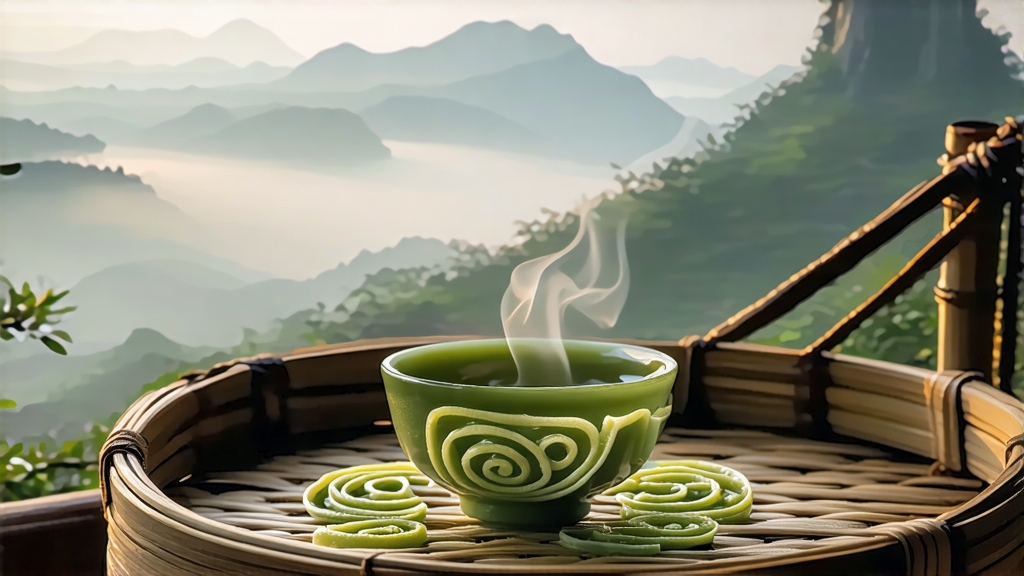
Among the pantheon of Chinese green teas, none is more poetically named or delicately fashioned than Biluochun—literally “Green Snail Spring.” The curled, jade-colored pellets, redolent of flowers and ripe orchard fruit, have captivated emperors, scholars, and now a new generation of global tea aficionados. To understand Biluochun is to step into a microclimate of mist, lake, and ancient gardens where every bud is a living archive of Chinese horticultural genius.
Origin & Legend
The tea hails from the Dongting Mountains of Jiangsu Province, twin peaks that rise from the shores of Lake Tai, China’s third-largest freshwater body. According to Qing-era gazetteers, a nun named Bi Luo discovered wild tea trees whose fragrance startled her during spring meditation. She plucked a handful, brewed them in an earthen kettle, and found the liquor so exquisite that local growers began cultivating the variety, naming it after her and the snail-like curl the leaf assumes during firing. Another court chronicle claims the Kangxi Emperor, touring the south in 1699, was served an unnamed tea whose “startling fragrance” filled the room. He christened it “Biluochun” on the spot, elevating it to tribute status.
Terroir: Lake Tai’s Mist Engine
Dongting’s unique mesoclimate is the invisible co-author of Biluochun’s flavor. The lake acts as a thermal reservoir, releasing cool moisture at dawn that condenses into a fog blanket. This natural shade reduces photosynthesis, forcing the plant to stockpile amino acids—especially L-theanine—yielding the tea’s hallmark sweetness and umami depth. Soils are quartz-sandstone derived, slightly acidic, and rich in selenium, trace elements that amplify floral volatiles. Even the mountain’s fruit orchards—peach, plum, and apricot—intercrop with tea bushes, their pollen and blossom scent absorbed by the pubescent young leaves, giving rise to Biluochun’s signature fruity note.
Cultivars & Grades
While the original landrace is the small-leaf “Dongting Qunti,” clonal selections such as “Dongting 1” and “Fuding Dabaicha” have been introduced to extend harvest windows. The industry recognizes seven official grades, differentiated by picking standard and bud-to-leaf ratio:
- Supreme Special (Chaowang): 100 % unopened bud, plucked before Qingming festival, 6,000 buds yield 500 g.
- Special Grade: one bud and one leaf just unfolding, length ≤1.5 cm.
- First to Fifth Grades: progressive inclusion of larger leaves, harvested pre-Grain Rain.
Plucking Ritual
Work begins at 5 a.m. when dew still weighs down the bushes. Pickers—predominantly women wearing indigo headscarves—use a three-finger “sparrow-peck” motion to snap the bud without bruising the stem. Baskets are woven from bamboo slats too wide to retain heat, preventing premature oxidation. A seasoned picker gathers barely 400 g of fresh leaf in four hours, the first lesson in why Biluochun commands imperial prices.
Crafting the Spiral: Six Hours from Garden to Green
Unlike pan-fired teas, Biluochun is wok-tossed and hand-rubbed in a choreography unchanged since the Ming dynasty.
- Withering: 30 min ambient wither on sieved bamboo trays; leaf loses 8 % moisture, becoming flaccid enough to bend without snapping.
- Fixation (Sha Qing): 180 °C wok, 4 min. The master’s palm tests temperature—too hot and proteins coagulate, too cool and grassy volatiles persist.
- Primary Rub: At 70 °C, the tea is rolled under palm pressure into strips; polyphenol oxidase is thermally denatured, locking in jade hue.
- Spiral Formation: The signature move—two-thumb spiral kneading on a bamboo mat. Temperature drops to 50 °C; leaves curl into tight spirals while epidermal hairs remain intact, the “white down” that glints like frost under light.
- Secondary Drying: 40 °C for 20 min reduces moisture to 7 %. Masters listen for a crisp “sand-sound” indicating proper brittleness.
- Final Selection